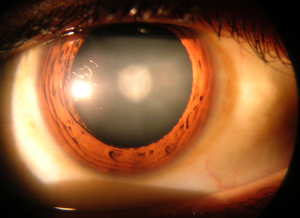Vision Loss and V1
86
Learning Objectives
Know what are the major causes of low vision in the U.S.
Being able to identify what parts of the eye are affected by cataracts, macular degeneration, and glaucoma.
Being able to describe the impact of different diseases on our visual function, e.g. visual acuity, visual field, and dark adaptation.
The leading causes of blindness and low vision in the United States are primarily age-related eye diseases such as age-related macular degeneration, cataract, diabetic retinopathy, and glaucoma. Other common eye disorders include amblyopia and strabismus.
Most cataracts are caused by normal changes in your eyes as you get older. When you’re young, the lens in your eye is clear. Around age 40, the proteins in the lens of your eye start to break down and clump together. This clump makes a cloudy area on your lens — or a cataract (Fig.9.2.1). Over time, the cataract gets more severe and clouds more of the lens.

Macular degeneration, often called age-related macular degeneration (AMD), is an eye disorder associated with aging and results in damaging sharp and central vision. AMD affects the macula, the central part the retina that allows the eye to see fine details. There are two forms of AMD: wet and dry.
Wet AMD is when abnormal blood vessels behind the retina start to grow under the macula, ultimately leading to blood and fluid leakage. Bleeding, leaking, and scarring from these blood vessels cause damage and lead to rapid central vision loss.
Dry AMD is when the macula thins over time as part of the aging process, gradually blurring central vision. As less of the macula functions over time, central vision is gradually lost in the affected eye.
AMD doesn’t cause complete blindness, but losing your central vision can make it harder to see faces, drive, or do close-up work like cooking or fixing things around the house. AMD happens very slowly in some people. Even if you have early AMD, you may not experience vision loss for a long time. For other people, AMD progresses faster and can lead to central vision loss in one eye or both eyes. As AMD progresses, many people see a blurry area near the center of their vision. Over time, this blurry area may get bigger or you may see blank spots. Things may also seem less bright than before. Some people may also notice that straight lines start to look wavy. This can be a warning sign for late AMD.
Glaucoma is a group of diseases that can damage the eye’s optic nerve and result in vision loss and blindness. Glaucoma occurs when the normal fluid pressure inside the eyes slowly rises. At first, glaucoma doesn’t usually have any symptoms. That’s why half of people with glaucoma don’t even know they have it. Over time, you may slowly lose vision, usually starting with your side (peripheral) vision—especially the part of your vision that’s closest to your nose. Because it happens so slowly, many people can’t tell that their vision is changing, especially at first. But as the disease gets worse, you may start to notice that you can’t see things off to the side anymore. Without treatment, glaucoma can eventually cause blindness.
CONTENT SHARED PREVIOUSLY
National Eye Institute, Cataracts
URL: https://www.nei.nih.gov/learn-about-eye-health/eye-conditions-and-diseases/cataracts
License: PDM
Center for Disease Control and Prevention, Common Eye Disorders and Diseases
URL: https://www.cdc.gov/visionhealth/basics/ced/index.html
License: PDM

